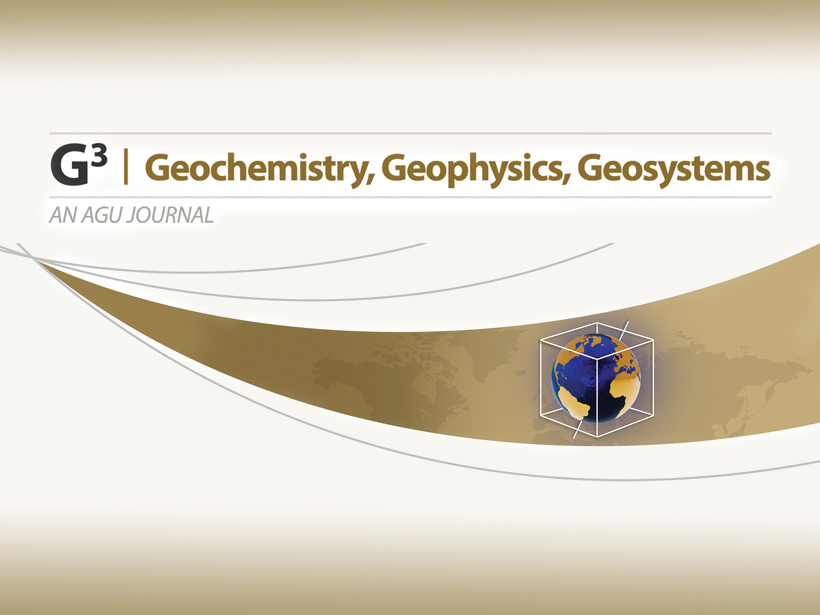We remain committed to exploring new ways of electronic publishing in an open and collaborative approach.
Geochemistry, Geophysics, Geosystems (or G-Cubed) is the premier interdisciplinary journal of the American Geophysical Union (AGU) and has been published since 2000 in collaboration with the Geochemical Society. The journal hosts intermediate-length articles (~10,000 words, ~10 figures) of broad community interest, covering Earth and planetary processes with a focus on understanding planets as a system. The journal’s editors welcome observational, experimental, and theoretical investigations of the solid Earth and planets, their hydrospheres and atmospheres, Earth’s biosphere, and the solar system at all spatial and temporal scales.
G-Cubed defines itself by its mission to publish the best process-level science. The journal has also led the transformation to online publication since its inception. We remain committed to exploring new ways of electronic publishing in an open and collaborative approach, working with authors; AGU; and John Wiley, our publisher, to help make complex, data-rich scientific studies widely accessible.
G-Cubed papers reach a wide readership whose residence is split roughly evenly between Europe, Asia, and the Americas, with a growing usage in Africa. In 2014, G-Cubed‘s impact factor was 3.054, and we published about 300 articles.
The journal’s team has always been proud of shepherding fair, fast, and detailed reviews. The current median time to first decision is very close to our target of 6 weeks. To achieve this efficiency, G-Cubed has recently expanded its editorial board. The current board of editors reflects the disciplinary breadth and geographic diversity of our readership; it consists of Janne Blichert-Toft (Ecole Normale Supérieure de Lyon), Ulrich Faul (Massachusetts Institute of Technology), Cin-Ty Lee (Rice University), Adina Paytan (University of California, Santa Cruz), Yusuke Yokoyama (University of Tokyo), and Thorsten W. Becker (University of Southern California), who also serves as editor in chief.
Editors now handle approximately 80% of all papers, but we also rely on the support of a team of about 15 associate editors when needed. This success builds, of course, on the continued support of our international group of experts who serve as reviewers for the journal, an enormous service effort for which we are deeply grateful.
G-Cubed continues to welcome submissions of articles that discuss—and technical reports that empower—cutting-edge science.
With our new publication and Web interface and an expanded editorial team, G-Cubed continues to welcome submissions of articles that discuss—and technical reports that empower—cutting-edge science. We are particularly keen to receive more papers that speak to the connections between parts of the Earth systems, for example, pertaining to the interface between the solid Earth and the exosphere; Earth and planetary evolution, including volatile cycles; the interactions between lithospheric and deep mantle dynamics; fault systems; and fault constitutive laws.
G-Cubed also hosts “themes,” which are collections of articles on particular topics. Unlike regular special sections, all papers within themes are published immediately after review, and the coherence of content is ensured by cross-linking and special associate editorial teams. We are currently seeking submissions for active themes on oceanic detachment faults; subduction processes in Central America; magnetism from atomic to planetary scales; the lithosphere-asthenosphere boundary; and magmatic, neovolcanic, hydrothermal, and biological processes along intraoceanic arcs and back arcs. We also welcome suggestions for new themes, and we look forward to working with authors to make sure that the journal serves the community’s science needs.
We are initiating a new series on frontiers in Earth systems with the inaugural theme on deep Earth–surface interactions.
To highlight new advances in science such as those arising currently through several National Science Foundation Frontiers in Earth System Dynamics projects and to reaffirm our commitment to facilitate discourse between the disciplines, we are now also initiating a new series on frontiers in Earth systems with the inaugural theme on deep Earth–surface interactions.
This theme will host a range of cutting-edge and sometimes provocative overview papers, covering Earth evolution as reflected in topics such as oxygenation; weathering and the carbon cycle; mass extinctions; convective interactions between the core, mantle, and the magnetic field; extreme climatic events; and solid Earth–climate interactions. The first set of these papers will be published in fall 2015. In addition, G-Cubed editors will be conveners, contributing authors, and invited speakers within a Union session on the same topic at the 2015 AGU Fall Meeting. This will further facilitate the debate of inherent scientific issues of Earth system science, within and outside of the journal.
More information about G-Cubed can be found on the journal website, and our AGU team and editors can be reached at [email protected].
In addition, feel free to contact the editor in chief directly with comments, questions, or suggestions. We look forward to continuing to work with the community to facilitate Earth systems science discourse and strive to have the journal meet the demands of a changing research landscape.
—Thorsten W. Becker, Editor in Chief, Geochemistry, Geophysics, Geosystems; University of Southern California, Los Angeles; email: [email protected]
Citation: Becker, T. W. (2015), G-Cubed: Building on 15 years of publishing process–level science, Eos, 96, doi:10.1029/2015EO031977. Published on 24 June 2015.
Text © 2015. The authors. CC BY-NC 3.0
Except where otherwise noted, images are subject to copyright. Any reuse without express permission from the copyright owner is prohibited.

